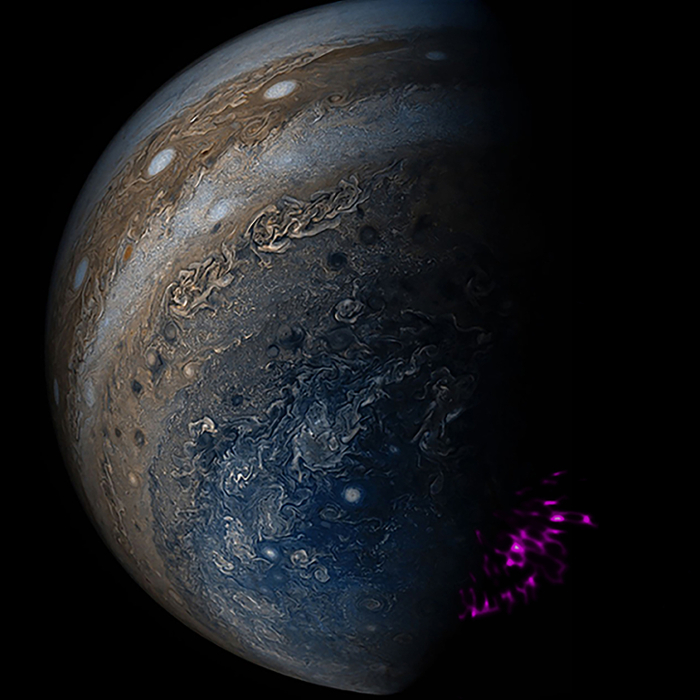
 Credit: X-ray: NASA/CXC/UCL/W.Dunn et al, Optical: South Pole: NASA/JPL-Caltech/SwRI/MSSS/Gerald Eichstäadt /Seán Doran
Credit: X-ray: NASA/CXC/UCL/W.Dunn et al, Optical: South Pole: NASA/JPL-Caltech/SwRI/MSSS/Gerald Eichstäadt /Seán Doran
The Beat of the X-ray Aurora
Jupiter is the largest and most
massive planet in our solar system, more massive than all the other planets
combined, nearly 318 times the mass of the earth. We know now that other
Jupiter-size planets exist in other solar systems, so that the formation of
large, massive planets like Jupiter may be fairly common, and may play a key
role in the formation of planetary systems. Jupiter, a bright naked-eye planet,
is itself is largely a mystery. Jupiter's atmosphere is
distinguished by swirling, banded ammonia clouds, and the famous Great
Red Spot, an enormous cyclonic storm bigger than two earths. The 9.8 hour
Jovian day is the shortest of any major planet. Jupiter's fast rotation helps
power a strong magnetic
field, which traps charged particles from the sun and produces a beautiful
light show near the north and south magnetic poles. This light-show is Jupiter's aurorae, its larger version of the
earth's Northern and Southern lights. Jupiter's aurorae, like earth's aurorae, are produced when high energy particles from the solar wind are trapped by the planet's magnetic field and funnelled towards the north and south magnetic poles, where they interact with atoms in the planet's atmosphere. When these energetic solar-wind particles collide with the atoms in the atmosphere near the magnetic poles, they energize electrons, which then lose energy, producing the auroral light. In the case of Jupiter, these interactions are so energetic that they produce high-energy X-ray emission. In fact, Jupiter is the only planet we know of which possesses an "X-ray aurorae". The image above shows a composite of an optical image of Jupiter, taken by the Juno orbiter,
and Jupiter's Southern X-ray aurora as viewed by the Chandra X-ray Observatory.
In addition to the mysterious origin of the X-ray aurorae on Jupiter, new observations with Chandra and the XMM-Newton X-ray Observatory also show that, for some reason, the northern and southern lights on Jupiter behave independently from one another: the southern aurora varies with an 11-minute timescale, while the northern aurora seems to vary randomly. This is unlike earth, where the northern and southern lights tend to behave in concert. New observations with Juno, and with Chandra and XMM-Newton, will provide important new details to unravel the mysterious interplay between Jupiter's strong magnetic field, the solar wind, and the planet's atmosphere.
Published: November 27, 2017
<
HEA Dictionary ● Archive
● Search HEAPOW
● Other Languages
● HEAPOW on Facebook
● Download all Images
● Education ● HEAD
>

Each week the HEASARC
brings you new, exciting and beautiful images from X-ray and Gamma ray
astronomy. Check back each week and be sure to check out the HEAPOW archive!
Page Author: Dr. Michael F. Corcoran
Last modified Tuesday, 27-Feb-2024 10:08:20 EST


